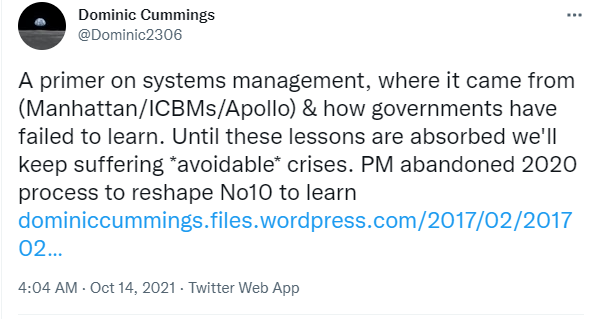The Cold Equations

Dominic Cummings re-posted a link to his 2017 discussion of systems engineering as applied to politics, and since it touches on just about every theme I like to discuss here at With Both Hands, I thought it would be worth exploring in some detail.
Systems engineering is something you could go to school for now. It would probably be a moderately useful credential if you wanted a job in the defense industry, but it is not known for providing unusually high incomes or producing unusually creative, productive, or brilliant thinkers. Which might have you wondering why Cummings would go out of his way to laud it.

He does so because systems engineering, and a number of related ideas, were pivotal in the course of World War II and the Cold War. That commoditizing those ideas and teaching them to large numbers of people has no noticeable effect is the kind of mystery you should ponder if you want to know why it seems like research productivity is [apparently] falling.
Cummings points out the biggest success of the systems engineering approach was the Apollo program, but he then goes into the history of these ideas in the twentieth century.
The beginning of modern American thinking on scientific management is Frederick Winslow Taylor. It is not exactly an auspicious beginning. Taylor’s ideas really did result in increased industrial production, but the style of work that he pioneered was dehumanizing and alienating, in an era when those things were already rampant:
He had attended the Phillips Exeter Academy, the closest America equivalent to Eton (where the likes of Gore Vidal went). He turned down Harvard to take a job in a factory which he later called ‘the most valuable part of my education’. He saw how everybody did things differently with no thought for what was most efficient. Initially workers resisted his attempts to tighten processes. He then decided to show them. He prowled the floor with a stopwatch, pen, and ledger. He broke down all the parts, measured them, and did experiments. Many workers saw it as humiliating and tried to rally support against being timed with a stopwatch. Their attempts to strike were undermined by his growing knowledge.
What had been skilled jobs relying on judgement became less skilled jobs performing simple repetitive tasks. He could let them go and hire new less skilled people. His approach brought gains from specialisation as per Adam Smith and David Ricardo. It depended on a rigid hierarchy in which those at the bottom were told not to think but to execute simple tasks in the exact way stipulated.
He called it ‘scientific management’. He told workers, ‘I have you for your strength and mechanical ability. We have other men paid for thinking.’
Cummings accurately describes the class-based elitism of Taylorism that made it widely hated even as it was widely adopted, because it really did work. The often cited fact that Henry Ford paid more for his assembly line work on cars is somewhat less often coupled with the fact that workers had to be paid more because the work was unsatisfying and repetitive. Let alone the consequences of what we would now call “repetitive stress injuries” on the workers in this kind of a system.
However, Taylorism was not the last word in efficiency. A thread that Cummings does not pick up is the origins of lean manufacturing in the United States in the 1930s. Walter Shewhart and W. Edwards Deming created ideas with a family resemblance to system engineering that required the active involvement of the people who actually do the work, but since those ideas took a long detour through Japan during the Cold War, they don’t figure prominently in the story Cummings tells.
It was the course of the Second World War that really got things going in systems engineering. The term used at the time was “operations research”:
Researchers were differentiated between those working purely on the technology, known as ‘developmental research’, and those working on the operational issues which became known as ‘operational research’ (OR). Crucially, the skills of both types were grounded in maths (pure and applied), physics, and engineering. The central point was to have people with quantitative problem-solving skills examining operational and institutional problems - not just the technology problems.
This kind of work had previously been done in the United States for war related reasons, for example the now ubiquitous PID controllers, used in lots of industrial equipment you’ve never heard of because it works perfectly all the time, were developed to steer ships for the US Navy in the 1920s. However, it was the Manhattan Project that really made people with power and influence sit up and take notice of the kind of results you could get by getting physicists and mathematicians to solve practical problems.
Which is related to my own cocktail party theory of one of the things that ails science in our day. Scientists need practical problems to solve, or they end up wasting massive amounts of time and money. However, I think you could just as accurately say that the way operations research and its later incarnation as systems engineering sucked a great deal of America’s best talent into the zero-sum game the Cold War turned into wasted a lot of time and money too.

The most fascinating interpretation of Orson Scott Card’s Ender’s Game is that it was a criticism of the immense amount of effort spent funneling the brightest into the Cold War effort.
Which brings us to the most fascinating intersection of this whole thing, science fiction. While I am very much a proponent of the idea that what we call science fiction is a needlessly restrictive label, the twentieth century development of this part of popular literature heavily overlaps, in both time and key figures, with the subject matter we are discussing.
John von Neumann, the greatest scientist and mathematician of the twentieth century, was a prominent contributor to the Manhattan Project, as well as the foundational disciples of systems engineering. He wrote “Can We Survive Technology?” in 1955, which is worth quoting at length:
‘“The great globe itself” is in a rapidly maturing crisis — a crisis attributable to the fact that the environment in which technological progress must occur has become both undersized and underorganised…
‘In the first half of this century the accelerating industrial revolution encountered an absolute limitation — not on technological progress as such but on an essential safety factor. This safety factor, which had permitted the industrial revolution to roll on from the mid-eighteenth to the early twentieth century, was essentially a matter of geographical and political Lebensraum: an ever broader geographical scope for technological activities, combined with an ever broader political integration of the world…
‘Now this safety mechanism is being sharply inhibited; literally and figuratively, we are running out of room. At long last, we begin to feel the effects of the finite, actual size of the earth in a critical way.
‘Thus the crisis does not arise from accidental events or human errors. It is inherent in technology's relation to geography on the one hand and to political organization on the other…
‘In all its stages the industrial revolution consisted of making available more and cheaper energy, more and easier controls of human actions and reactions, and more and faster communications. Each development increased the effectiveness of the other two. All three factors increased the speed of performing large-scale operations — industrial, mercantile, political, and migratory. But throughout the development, increased speed did not so much shorten time requirements of processes as extend the areas of the earth affected by them. The reason is clear. Since most time scales are fixed by human reaction times, habits, and other physiological and psychological factors, the effect of the increased speed of technological processes was to enlarge the size of units — political, organizational, economic, and cultural — affected by technological operations. That is, instead of performing the same operations as before in less time, now larger-scale operations were performed in the same time. This important evolution has a natural limit, that of the earth's actual size. The limit is now being reached, or at least closely approached…
‘The advent of nuclear weapons merely climaxes the development. Now the effectiveness of offensive weapons is such as to stultify all plausible defensive time scales. As early as World War I, it was observed that the admiral commanding the battle fleet could “lose the British Empire in one afternoon.” Yet navies of that epoch were relatively stable entities, tolerably safe against technological surprises. Today there is every reason to fear that even minor inventions and feints in the field of nuclear weapons can be decisive in less time than would be required to devise specific countermeasures. Soon existing nations will be as unstable in war as a nation the size of Manhattan Island would have been in a contest fought with the weapons of 1900.
‘Also likely to evolve fast — and quite apart from nuclear evolution — is automation… Fundamentally, improvements in control are really improvements in communicating information in an organisation or mechanism. The sum total of progress in this sphere is explosive… Probably intervention in atmospheric and climatic matters will come in a few decades, and will unfold on a scale difficult to imagine at present… ‘All this will merge each nation’s affairs with those of every other…
Von Neumann is here discussing exactly the same themes as Rudyard Kipling’s 1909 story “With the Night Mail”, but with the emotional valence reversed. On the other side of the two world wars, things went from “and this will be awesome” to “and this will be terrible”.
This whole period of science fiction is in fact known as “The Age of Despair”, when almost all the stories turned to apocalyptic themes, death and destruction. If even von Neumann felt that way, can you blame those authors? They were at least aspiring to the same concepts of the world, even if von Neumann was so far above the science fiction authors as to be utterly unlike. Asimov and Heinlein both worked in operations research style things during World War II, but neither had the kind of mind or influence or results that von Neumann did.
The final coincidence or overlap I would like to leave you with is one of my favorite science fiction authors, Jerry Pournelle. What makes Jerry such a fascinating part of all this is that he personally unified everything at play. Jerry himself was a part of the Deep State, before that term was commonly used. Specifically, he was part of the operations research wing of the military-industrial-intelligence complex. When he finished that up, he became a science fiction author. And after that, he used his popularity and his connections to help move state policy away from the operations research inspired Cold War doctrine of Mutually Assured Destruction.
So, I really do think that Cummings is on to something here. Although, we should keep in mind the inherent limitations of systems engineering or operations research to change the world. Just the principles aren’t enough, you need the right kind of mind to apply it, combined with the power to make it stick. And we should also keep in mind McNamara’s folly, a prominent example of a massive failure of trying to apply these principles to the management of the Vietnam War.

Comments ()